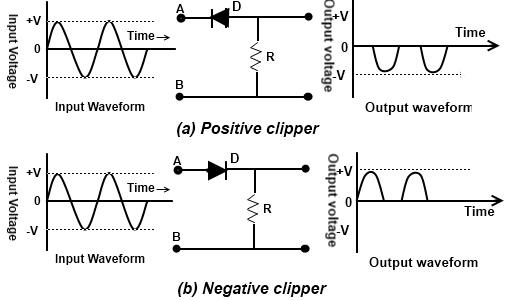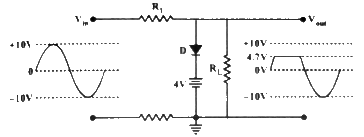Clipper & Clamper
A circuit that clips the input signal at a specified level above or below is called a clipper. A clipper that clips the positive half-cycle of an input signal is called a positive clipper. A clipper that clips the negative half-cycle of an input signal is called a negative clipper.

Figure (a) shows the circuit of a positive clipper. It consists of a diode D and a resistor R with outputs taken across the resistor. During the positive half cycle of the input voltage, terminal A is positive with respect to B. This reverse biases the diode and it acts as an open switch. Therefore all the applied voltage drops across the diode and none across the resistor. As a result, there is no output voltage during the positive half cycle of the input voltage.
During the negative half cycle of the input voltage, terminal B is positive with respect to A. Therefore it forward biases the diode and it acts as a closed switch. Thus, there is no voltage drop across the diode.
During a negative half-cycle of the input voltage. All the input voltage drops across the resistor as shown in the output waveform.
Figure (b) shows the waveform of the input voltage. During the positive half cycle of the voltage, terminal A is positive with respect to terminal B. Therefore the diode is forward biased; as a result, all the input voltage appears across the resistor.
During a negative half cycle of the input voltage, terminal B is positive with respect to terminal A. Therefore the diode is reverse biased and hence there is no voltage drop across the resistor during a negative half cycle.
Biased Clipper Circuit
If the bias voltage is placed in series with a diode then the circuit is called a biased clipper or limiter circuit. This bias determines the point where the diode begins to conduct and the duration of conduction. With bias, clipping can be done to any percent of the input signal ranging from 1% to 99%.
Single End Clipper

Figure (c) shows a single-end positive clipper. Notice that the positive terminal of the battery is connected to the diode cathode, therefore, the diode conducts when the input voltage reaches the level of 4.7 volts (VBias + 0.7). And when a diode is conducting there will be no current in RL and no voltage will drop across RL. So that all the input voltage above this level will be clipped off at the output.
If the bias voltage is varied up or down the clipping level changes correspondingly.
Double Diode Clipper
A circuit that can be used to limit the peaks of both half cycles of an A.C. input signal is called a double-end clipper.

A circuit diagram for this circuit is shown in Figure (d)
Notice that this circuit contains a shunt positive clipper with positive bias and a shunt negative clipper with negative bias.
When the biased voltage reaches +8.7V diode D1 conducts and above that volt level no current flow through RL. Hence limiting the waveform to 8.7V. Diode D2 does not conduct until the voltage reaches -6.7V and negative voltage bellows -6.7V are clipped off. The resulting output waveform is shown at the output of the circuit.
Clamping
A circuit that clamps either the positive or negative peak of a signal at a desired D.C. level is known as a clamping. A clamping adds D.C components to the signal and does not change the shape or amplitude of the input signal.
Diode Clampers
Positive Clamper
The diode clamping circuit simply consists of a diode D and capacitor C as shown in the below Figure.

During the negative half cycle of the input voltage Vin the diode is forward biased and the current flows through the circuit. As a result of this, the capacitor C is charged to a voltage equal to the negative peak value i.e., -Vm. Once the capacitor is fully charged to -Vm it cannot discharge because the diode cannot conduct in the reverse direction. It means that this capacitor acts as a battery with an emf equal to the -Vm. The polarity of this voltage is such that it adds to the input signal. Therefore the output voltage is equal to the sum of the A.C input signal and the capacitor voltage Vm i.e., Vin + Vm.
Negative Clamper
If we change the polarity of the diode and capacitor, then the circuit becomes a negative clamper.
